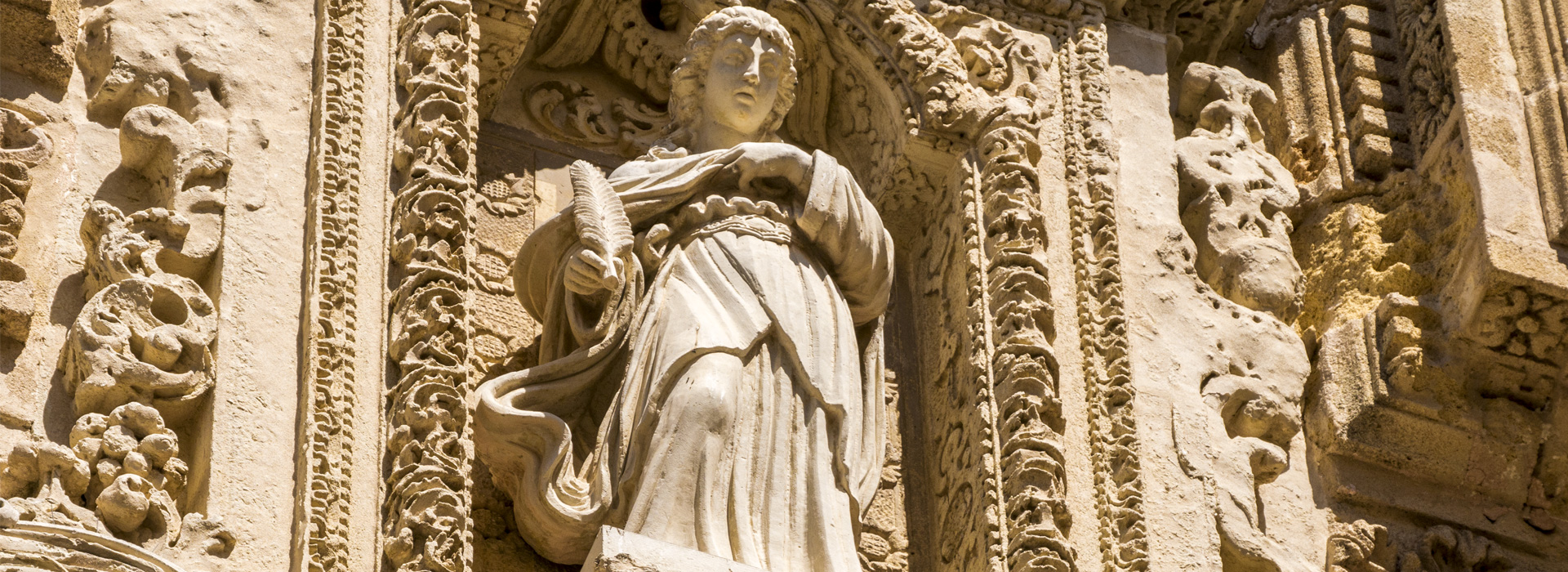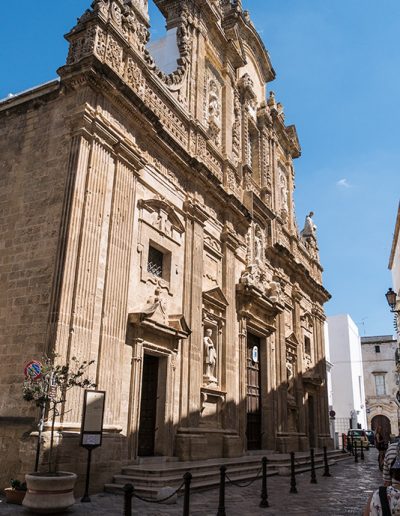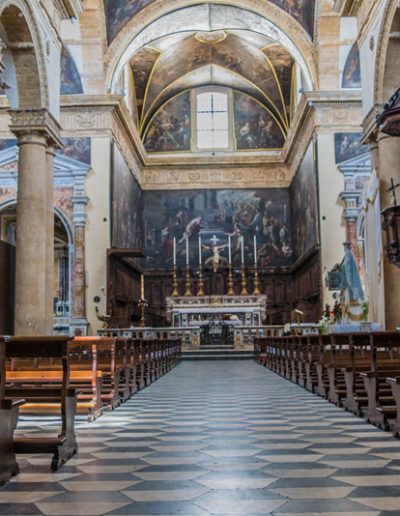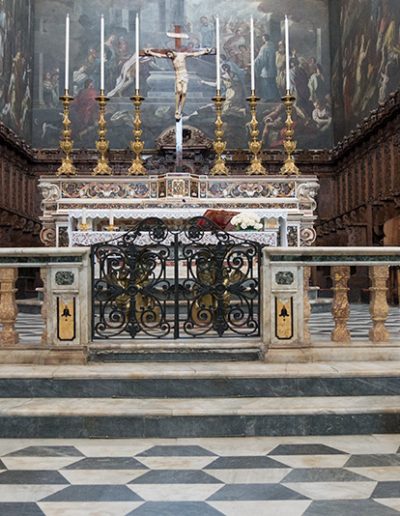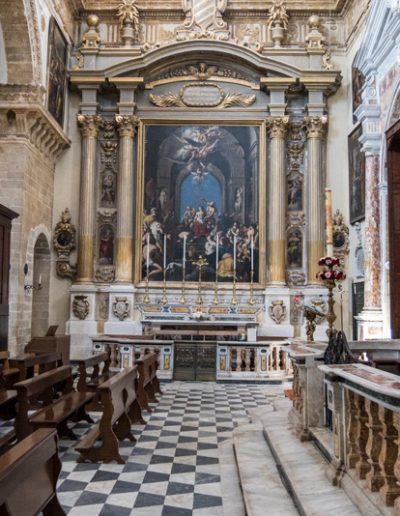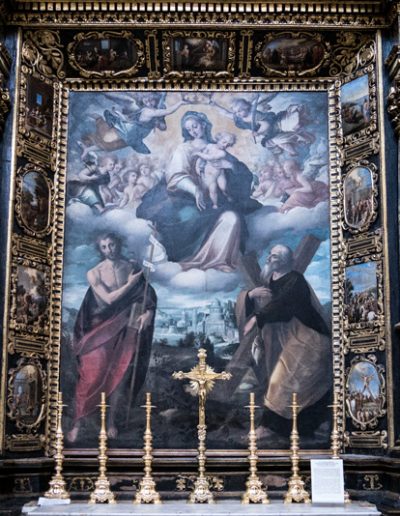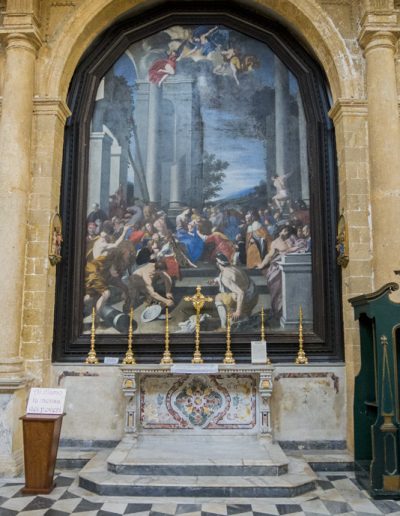Gallipoli: the Cathedral of St. Agatha Virgin and Martyr of Catania.
In the heart of Gallipoli Vecchia, Gaddhripuli, as the old Gallipolini fishermen say, who fought almost a century against the sea, there is a splendid treasure of immeasurable value: the cathedral of Sant’ Agata, virgin and martyr from Catania.
The cathedral of Gallipoli is a real artistic spectacle: you will remain open-mouthed
The spectacle that will appear before you is unique. Incredibly beautiful its façade on the outside, just as fascinating its interior, rich in paintings.
The façade of Giuseppe Zimbalo, the father of Salento’s baroque
The façade created by Giuseppe Zimbalo (the father of Baroque in Salento) is in carp, a typical Salento stone that takes on a colour with golden reflections.
The interior is rich, baroque, not trivial and never taken for granted. Rich in paintings.
It will seem strange to hear it said, but in Gallipoli, such a unique concentration of art, in this incredible architectural masterpiece, it had never been seen before.
Prospectus of Zimbalo in carp and Latin cross plan with thirteen altars, by architect G. B. Genuino
Let’s proceed with the description even if the words, in this case, may be unsuitable to describe a heritage of such great beauty.
Its construction began in 1726, designed by the architect Giovanni Bernardino Genuino, after the demolition of the 11th century church dedicated to San Giovanni Crisostomo.
The elevation was completed in 1696 and is divided into two orders: in the first order the three portals open, the largest of which is surmounted by the beautiful statue of Sant’ Agata.
Two other statues on the sides: on the left side San Sebastiano and on the right side San Fausto.
The second order of the façade has been finely decorated by Zimbalo: anthropomorphic and phyto-morphic figures and statues of Santa Marina, Santa Teresa and Saints Chrysostom and Augustine are present.
Painting is the undisputed queen, inside the cathedral of S. Agata
Inside the cathedral, painting takes precedence over everything, becoming the undisputed queen of Baroque decoration.
Latin cross plant, three naves and twelve columns, thirteen altars: 6 on the right, 6 on the left and the main altar in the center, all surmounted by paintings of the highest level.
Here we list here the title and author of each work in the aisles, sure to do you what you like. An entire website would not suffice to describe them in detail. At the end of this post you will find a detailed gallery on the topic.
The right aisle and the works present
The right aisle contains works of exceptional workmanship.
These are:
- Madonna in glory among the SS. Niccolò and Oronzo (of G. A.Coppola);
- Assumption of the Virgin (of G. A.Coppola)<;/li>
- The holy souls of the Purgatory (of G. A.Coppola);
- Immaculate with S. Agata and S. Agata. Leo (maybe by F. Genovino);
- The martyrdom of St. Sebastian (of N. Malinconico);
- Triumph of the Eucharist with St. John Nepomuceno and St. Thomas Aquinas (of F. Giordano)
- the Sleep of Saul and the Adoration of a vigil (of N. Malinconico);
The High Altar: Saint Agate, the Pool Probatic and the Entrance of Jesus to Jerusalem
Behind the high altar, in the choir area, you can see:
- the Sepulchre of St. Agate;
- the Pool Probatica (the pool in which the miracle of the paralytic described in the Gospel occurred);
- Jesus’ Entrance into Jerusalem.
All these works were made by the Malinconico.
The left aisle and the works of Coppola, Giordano and Malinconico
The left nave has the following works:
- S. Isidoro Agricola (L.Giordano);
- Miracle of St. Francis of Paola (G. A. Coppola);
- Adoration of the Magi (G. A. Coppola);
- Virgin and Child between St. John the Baptist and St. Andrew the Apostle (G.D. Catalano);
- Martyrdom of St. Agate (G. A. Coppola);
- S. Maria del Popolo (unknown author);
- Marriage of Mary and escape to Egypt (N. Malinconico).
Paintings on the roof of the nave
The paintings by the artists mentioned above illustrate the coverage of the central nave, the dome, the sides of the church with themes related to life, miracles and martyrdom of St. Agatha.
S. Agata and the inhabitants of Gallipoli: a curious legend
An ancient legend from Gallipoli’s inhabitants tells us that on the city’s beach, a cut breast of the Catania martyr was found. This sacred relic has been preserved for a long time in the city of Gallipoli. At a later stage, the upper portion of this relic was stolen and transferred to the church of St. Catherine of Alexandria, in Galatina (Lecce) where it is still preserved.
